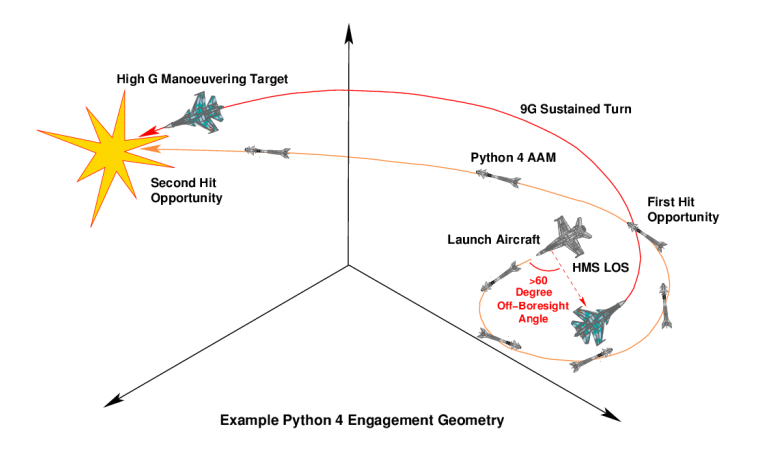الاخ الكريم
معلومه عامه .. قد تكون غير كامله او وافيه .. و ساضع روابط لمن يرغب فى الاستزادهصوره توضيحيه

........................
الفكره العامه (
قد تكون غير كامله او وافيه ).. تمتلك بعض الصواريخ هذه الميزه .. و تستعمل بالتكامل مع خوذات HMS للطيارين للتصويب بتوجيه النظر الى الهدف بغض النظر عن اتجاه الطيران
باسلوب Off-Boresight
فى هذه الطريقه يقوم الطيار باستعمال التصويب بالخوذه .. و بعد انطلاق الصاروخ يعمل lock
على اول هدف يراه ( عاده يستعملها الطيار عندما يكون الوضع حرجا و لا يتمكن الطيار من اتخاذ الوضعيه الصحيحه لمهاجمه الهدف ) .. و لا اعلم اخر المستجدات ( فهل مثلا الان يمكن تلقيم الصاروخ ببيانات الهدف قبل الاطلاق عن طريق الخوذه .. ثم بامكانيات الصاروخ نفسه يقوم باتخاذ اتجاه المسار المناسب
للهدف المحدد قبل اكتساب سرعته القصوى .. اعتقد ممكن جدا و اعتقد ان هذا موجود فى الصواريخ و الخوذات الحديثه .. يلزم بعض الاستزاده فى البحث لمن يرغب )
كما ان هذه القدره ( Off-Boresight ) ترجع ايضا لامكانيات للصاروخ نفسه حسب تصميمه .. و اعتقد ان هذه الميزه متوفره لاكثر من طائره من الجيل الرابع و اكثر من صاروخ حديث
................................
Start of the 21st century missiles such as the ASRAAM use an “imaging infrared" seeker which “sees” the target (much like a digital video camera), and can distinguish between an aircraft and a point heat source such as a flare. They also feature a very wide detection angle, so the attacking aircraft does not have to be pointing straight at the target for the missile to lock on. The pilot can use a helmet mounted sight (HMS) and target another aircraft by looking at it, and then firing. This is called “off-boresight” launch. For example, the Russian Su-27 is equipped with an infra-red search and track (IRST) system with laser rangefinder for its HMS-aimed missiles.
In order to maneuver sufficiently from a poor launch angle at short ranges to hit its target, missiles are now employing gas-dynamic flight control methods such as vectored thrust, which allow the missile to start turning “off the rail”, before its motor has accelerated it up to high enough speeds for its small aerodynamic surfaces to be useful.
..............................
The Vympel R-73 (
AA-11 Archer) entered service in 1985 and marked a new generation of dogfight missile. These missiles employed more advanced seeker technologies such as focal plane arrays that improved resistance to infrared countermeasures (IRCM) such as flares and increased off-bore sight capability to in excess of 60 degrees, i.e. a 120 degree field of view.
To take advantage of the increased field-of-view that now exceeded the capabilities of most aircraft radars also meant that helmet mounted sights gained popularity.[7] Many newer missiles include what is known as “look-down-shoot-down” capability, as they could be fired onto low flying planes that would formerly be lost in ground clutter.These missiles are also much more agile, some by employing thrust vectoring (typically gimballed thrust)
...............................
روابط للاستزاده
http://en.wikipedia.org/wiki/Helmet-mounted_display
http://en.wikipedia.org/wiki/Air-to-air_missile
http://theaviationist.com/tag/high-off-boresight/#.Ubuhkme58n0
تحياتى